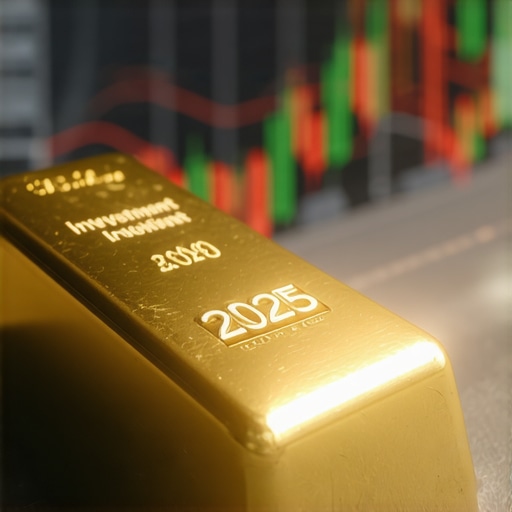Understanding Gold’s Unique Role as an Inflation Hedge
Gold has long been revered as a safe haven asset, especially during periods of rising inflation. The intrinsic value of gold and its limited supply underpin its capacity to preserve purchasing power when fiat currencies depreciate. Professional investors recognize that gold’s inverse correlation with inflation metrics, such as the Consumer Price Index (CPI), makes it an indispensable tool for portfolio diversification and risk mitigation in inflationary environments.
Advanced Strategies for Leveraging Gold to Counter Inflationary Pressures
Strategic allocation of gold within an investment portfolio requires more than simply buying physical bullion. Sophisticated investors consider a blend of gold investment vehicles, including gold ETFs and mutual funds, which provide liquidity and reduce storage risks, alongside physical assets like bars and coins for tangible security. Additionally, gold futures contracts offer a method to hedge against short-term inflation surges with leveraged exposure, though they demand rigorous risk management.
How Do Central Bank Gold Purchases Influence Inflation Hedging Strategies?
Central banks’ gold buying programs significantly impact global demand and price stability, directly affecting investors’ inflation hedging calculations. When central banks increase gold reserves—often as a response to currency volatility or inflation concerns—it signals confidence in gold’s value preservation capabilities. This dynamic can drive price appreciation, enhancing gold’s effectiveness as an inflation hedge. Investors should monitor central bank activities detailed in reports such as Central Bank Gold Buying: Its Influence on Global Demand to align their strategies accordingly.
Risk Considerations and Portfolio Integration for Inflation Protection
Despite gold’s reputation, it is essential to understand its limitations. Price volatility, opportunity costs, and geopolitical factors can affect gold’s performance. Therefore, integrating gold requires a nuanced approach balancing exposure with other inflation-resistant assets like real estate or inflation-indexed bonds. Diversification within gold holdings—balancing physical gold, ETFs, and mining stocks—can also optimize risk-adjusted returns.
To deepen your understanding of gold’s role in inflation protection and explore sophisticated investment tactics, consider reviewing the comprehensive guide on using gold as a hedge against inflation. Your expertise and insights on this evolving topic are valuable; join discussions among professionals to exchange advanced strategies and market analyses.
For authoritative, data-driven insights on gold’s long-term effectiveness against inflation, refer to the World Gold Council’s research publications, such as their report on Investment Demand and Inflation Correlations.
Integrating Gold Within a Multi-Asset Inflation Protection Framework
While gold is a cornerstone asset for guarding against inflation, its optimal use lies within a carefully balanced multi-asset portfolio. Allocating capital between gold, inflation-protected securities such as TIPS, real estate investment trusts (REITs), and commodities can yield superior inflation-adjusted returns while smoothing volatility. Investors should consider correlations and liquidity profiles when blending these assets, ensuring gold complements rather than duplicates inflation exposures. Regular portfolio rebalancing aligned with inflation trend forecasts enhances resilience and capital preservation.
Gold Supply Dynamics and Their Implications for Inflation Hedging
Understanding the supply side is critical for anticipating gold’s inflation-hedging performance. Primary mining output tends to grow modestly, constrained by geological and technological factors, while secondary supplies fluctuate with recycling rates influenced by price movements. Moreover, geopolitical events affecting major mining regions can disrupt supply, potentially causing price spikes. Investors must stay attuned to these dynamics to anticipate shifts in gold’s scarcity premium, which directly impacts its inflation-protection effectiveness.
What Emerging Market Trends Could Reshape Gold Demand and Inflation Hedging Strategies?
Emerging markets, particularly in Asia, continue to drive significant gold demand growth due to increasing wealth, cultural factors, and financial market development. This demand can influence global price trajectories and volatility patterns. Additionally, innovations such as digital gold tokens and evolving regulatory frameworks are transforming how gold is accessed and traded. These trends necessitate a re-examination of traditional inflation hedging approaches, incorporating alternative gold investment avenues and regional market considerations.
For investors seeking to refine their understanding of gold demand drivers and their inflation-hedging implications, the World Gold Council provides in-depth analysis and market intelligence. Their latest findings on Gold Demand Trends 2025 offer invaluable context for strategic decision-making.
Mitigating Risks in Gold Investments Amid Inflationary Environments
Despite gold’s benefits, investors must vigilantly manage risks such as price volatility, counterparty risk in paper gold investments, and liquidity constraints in physical holdings. Employing options and futures for hedging can mitigate downside risk but requires expertise and monitoring. Moreover, due diligence in selecting reputable dealers and custodians is paramount to avoid fraud or mispricing. Enhanced security measures and insurance for physical gold holdings further safeguard against loss or theft.
To explore best practices in buying and storing physical gold securely, consider the expert tips detailed in Best Physical Gold Storage Solutions & Safety Tips for Investors.
Engage with our community: Share your strategies or questions about integrating gold into inflation-resistant portfolios. Your insights help foster a more robust understanding of this evolving asset class. For further expert guidance, explore Top Gold Investment Strategies to Hedge Wealth in 2025.
Dynamic Gold Allocation: Tailoring Exposure to Inflationary Cycles for Maximum Portfolio Resilience
Seasoned investors know that static gold allocations often fail to capture the nuanced inflationary cycles characteristic of modern economies. Employing a dynamic allocation model, which adjusts gold exposure based on real-time inflation expectations, interest rate movements, and macroeconomic signals, can significantly enhance portfolio resilience. This approach leverages quantitative indicators such as breakeven inflation rates derived from Treasury Inflation-Protected Securities (TIPS) and forward-looking commodity price indices to time gold purchases and sales effectively.
For example, when inflation expectations surge above historical averages while real interest rates remain negative or near zero, increased gold exposure can capitalize on anticipated price appreciation. Conversely, in deflationary or disinflationary environments, it may be prudent to reduce physical gold holdings in favor of more liquid, income-generating assets.
Integrating Behavioral Finance Insights to Optimize Gold Investment Decisions Under Inflation Uncertainty
Beyond quantitative models, incorporating behavioral finance principles can refine gold investment strategies amid inflation volatility. Investors frequently exhibit herd behavior and recency bias, leading to suboptimal timing and allocation decisions. Recognizing these cognitive biases allows portfolio managers to implement systematic rebalancing rules and contrarian positioning to exploit market inefficiencies.
For instance, during periods of heightened inflation fears, gold prices often spike disproportionately due to panic buying. A contrarian strategy might involve reducing gold exposure after such spikes, anticipating mean reversion. Conversely, during complacent phases where inflation risk is underestimated, opportunistic accumulation of gold at undervalued levels can enhance long-term returns.
How Can Machine Learning Enhance Gold Price Forecasting and Inflation Hedging Strategies?
Machine learning (ML) techniques are increasingly utilized to analyze complex, nonlinear relationships between macroeconomic variables and gold prices, offering refined predictive capabilities. Algorithms such as Long Short-Term Memory (LSTM) networks and Random Forests process vast datasets encompassing CPI indices, currency exchange rates, interest rates, geopolitical risk indicators, and even social media sentiment to generate probabilistic forecasts of gold’s inflation-hedging effectiveness.
These ML-driven insights empower investors to dynamically adjust gold allocations with higher precision than traditional econometric models. However, successful implementation demands rigorous data curation, model validation, and continual retraining to accommodate shifting market paradigms.
For a comprehensive exploration of machine learning applications in gold investment, consult the ScienceDirect paper on ML-based gold price forecasting, which provides empirical evidence and methodological frameworks.
Evaluating Tax Implications and Regulatory Nuances in Gold-Based Inflation Hedging
Investors must account for the tax treatment of various gold investment vehicles, as it materially affects net returns and strategy viability. Physical gold, such as coins and bars, often incurs collectibles tax rates upon sale, which can be significantly higher than capital gains tax on ETFs or mining stocks. Additionally, regulations governing gold trading vary widely across jurisdictions, influencing liquidity and transaction costs.
Understanding these nuances enables sophisticated investors to structure portfolios that optimize after-tax inflation protection. For instance, allocating a portion of gold exposure to exchange-traded products domiciled in tax-advantaged jurisdictions or utilizing retirement accounts can enhance tax efficiency.
Gold Mining Stocks and ETFs: Leveraging Operational Leverage to Amplify Inflation Hedge Benefits
Gold mining equities inherently possess operational leverage to gold prices, often outperforming physical gold during inflationary spikes due to increased profit margins. However, they also introduce company-specific risks such as management quality, geopolitical exposure, and operational disruptions.
Incorporating gold mining ETFs or select high-quality mining stocks can thus complement physical gold holdings, providing enhanced upside potential while maintaining inflation hedging characteristics. Investors should conduct thorough due diligence and consider diversification across mining jurisdictions to mitigate idiosyncratic risks.
Engage with our community: Are you utilizing dynamic allocation models or machine learning techniques in your gold inflation hedge strategy? Share your experiences or questions to foster a deeper dialogue among experts navigating complex inflationary landscapes.
Algorithmic Insights: Revolutionizing Gold Allocation in Volatile Inflation Regimes
Building upon traditional methodologies, integrating algorithmic trading frameworks enhances gold allocation strategies amid increasingly volatile inflationary cycles. By leveraging real-time macroeconomic data feeds, including inflation surprises, monetary policy shifts, and geopolitical stress indices, algorithmic models dynamically recalibrate gold exposure to optimize risk-adjusted returns. These systems can execute tactical buys or sells within milliseconds, capitalizing on transient inefficiencies that manual strategies often miss. Institutional-grade platforms now incorporate multi-factor models blending fundamental, technical, and sentiment indicators to preempt inflation-driven market rotations.
What are the implications of integrating sentiment analysis into gold price forecasting for inflation hedging?
Sentiment analysis, harnessing natural language processing (NLP) on diverse textual datasets—from central bank communications to global news and social media—provides nuanced insights into market psychology that traditional quantitative models may overlook. Incorporating sentiment metrics alongside macroeconomic indicators enriches gold price forecasting models by capturing shifts in investor confidence and fear levels related to inflation expectations. This multidimensional approach enables more precise timing of gold accumulation or liquidation, reducing exposure during overbought conditions linked to panic and enhancing entry points during complacency phases.
For an authoritative perspective on advanced forecasting methodologies, consult the CFA Institute’s research on leveraging sentiment in financial markets, which offers comprehensive frameworks and empirical validations.
Incorporating ESG Metrics into Gold Mining Investments: A Paradigm Shift for Inflation-Resilient Portfolios
The growing prominence of Environmental, Social, and Governance (ESG) criteria in investment decisions mandates a re-evaluation of gold mining equities within inflation-hedging portfolios. Mining operations with robust ESG practices tend to exhibit lower regulatory and reputational risks, translating to enhanced operational stability and long-term value preservation during inflationary pressures. Moreover, ESG-compliant mines often access capital at more favorable terms, which can amplify returns when gold prices surge.
Investors should adopt ESG scoring frameworks tailored to the mining sector to discern companies with sustainable practices that align with inflation protection objectives. Integrating ESG analytics thus not only addresses ethical considerations but also fortifies the inflation hedge by mitigating idiosyncratic risks inherent in mining stocks.
Exploring Crypto-Gold Tokenization: Bridging Digital Innovation and Traditional Inflation Hedges
Tokenization of physical gold assets on blockchain platforms introduces a novel dimension to inflation hedging by enhancing liquidity, transparency, and accessibility. Digital gold tokens, backed by verifiable reserves, allow fractional ownership and instantaneous settlement, democratizing exposure to gold’s inflation protection benefits. This innovation reduces barriers for retail and institutional investors, facilitating portfolio diversification with minimal friction.
However, tokenization also introduces unique counterparty and regulatory risks. Evaluating the custodial integrity of underlying reserves and compliance frameworks is paramount. As regulatory landscapes evolve, tokenized gold could redefine conventional inflation hedging paradigms by merging decentralized finance (DeFi) efficiencies with time-tested asset security.
Leveraging Advanced Derivatives: Tailored Options Strategies for Enhanced Inflation Hedging
Beyond straightforward futures and spot positions, sophisticated derivatives strategies—such as collar trades, ratio spreads, and calendar spreads—offer nuanced inflation hedging capabilities tailored to investor risk tolerance and market outlooks. For example, protective collars allow investors to cap downside risk while retaining upside participation during inflation-driven gold rallies, optimizing the risk-reward profile.
Advanced options trading necessitates expert understanding of implied volatility surfaces and time decay dynamics, enabling tactical adjustments aligned with inflation volatility forecasts. Incorporating volatility skew analyses further refines hedge calibration, ensuring exposures remain responsive to evolving inflation scenarios.
Engage with Expert Discourse: Elevate Your Gold Inflation Hedge Strategy
Embracing these frontier strategies demands continuous learning and peer collaboration. We encourage you to delve deeper into algorithmic models, ESG integration, tokenization innovations, and derivatives mastery to elevate your inflation hedging acumen. Share your insights or queries with our expert community to foster a rich dialogue on the evolving nexus of gold investment and inflation protection.
Expert Insights & Advanced Considerations
Dynamic Allocation Enhances Inflation Protection
Adapting gold exposure responsively to inflationary cycles, interest rate fluctuations, and macroeconomic indicators significantly improves portfolio resilience. Investors leveraging quantitative signals like breakeven inflation rates and commodity price indices can time gold accumulation and liquidation more effectively, optimizing inflation hedge outcomes.
Integrating Behavioral Finance Refines Timing and Allocation
Recognizing cognitive biases such as herd behavior and recency bias enables sophisticated investors to implement systematic rebalancing and contrarian strategies. This psychological insight reduces the risk of overpaying during panic-driven price spikes and identifies undervalued entry points when inflation concerns are muted.
Machine Learning Unlocks Nuanced Gold Price Forecasting
Employing advanced algorithms, including LSTM networks and Random Forest models, to analyze complex macroeconomic and sentiment data enhances predictive accuracy for gold’s inflation hedging effectiveness. This approach facilitates more precise, data-driven portfolio adjustments in volatile inflation environments.
ESG Integration Strengthens Mining Stock Inflation Hedges
Incorporating Environmental, Social, and Governance metrics into gold mining equity selection mitigates operational and reputational risks, fostering sustainable inflation-resilient returns. ESG-compliant mining companies typically demonstrate greater stability and capital access advantages amid inflationary pressures.
Gold Tokenization Expands Access but Demands Scrutiny
Digital gold tokens provide increased liquidity and fractional ownership, democratizing inflation hedge opportunities. However, investors must diligently evaluate custodial transparency and regulatory compliance to manage unique counterparty and legal risks inherent in tokenized assets.
Curated Expert Resources
- World Gold Council – Investment Demand and Inflation Correlations: Comprehensive research on gold’s historical relationship with inflation, invaluable for understanding long-term hedge dynamics (source).
- ScienceDirect – ML-Based Gold Price Forecasting Paper: Detailed empirical study showcasing machine learning applications in predicting gold prices and inflation hedge effectiveness (source).
- CFA Institute – Leveraging Sentiment in Financial Markets: Authoritative guidance on integrating sentiment analysis with macroeconomic data to refine gold price forecasting (source).
- BuyingGoldNow – Central Bank Gold Buying Impact: Insightful analysis of how central bank purchases influence global gold demand and inflation hedging strategies (source).
- BuyingGoldNow – Best Physical Gold Storage Solutions & Safety Tips: Practical advice for securely storing physical gold, crucial for preserving inflation hedge value (source).
Final Expert Perspective
Gold’s role as a sophisticated inflation hedge transcends simple ownership of bullion, demanding dynamic strategies informed by behavioral insights, advanced analytics, and evolving market structures. Integrating ESG considerations and embracing digital innovations like tokenization further refines inflation protection within diversified portfolios. For professionals committed to mastering gold as a hedge against inflation, continuous engagement with cutting-edge research and peer discourse is essential. We invite you to deepen your expertise by exploring advanced strategies and sharing your perspectives through authoritative resources such as Top Gold Investment Strategies to Hedge Wealth in 2025 and actively participating in expert discussions shaping the future of inflation-resilient investing.









